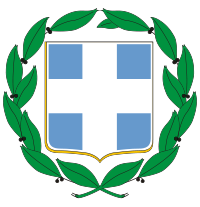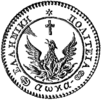- National emblem of Greece
-
National emblem of Greece 
Versions 
Military version, used by the Greek military and security services and on the Presidential Standard
Unofficial coloured version of the emblem
Example of use on seals of state services: seal of the General Secretariat for Macedonia and ThraceDetails Armiger the Hellenic Republic Adopted 1975 Escutcheon Azure, a cross throughout Argent Other elements The escutcheon is wholly surrounded by two laurel leaves. The national emblem of Greece (Greek: Εθνόσημο της Ελλάδας, Ethnósimo tis Elládas), also known as the coat of arms of Greece, consists of a blue escutcheon with a white cross totally surrounded by two laurel branches. The emblem is painted or woven, mainly on the hats, uniforms and buttons of the military, the security forces, etc.
Contents
History
The first Greek national emblem was provided for by the Constitution of Epidauros of 1 January 1822 and was established by decree on 15 March of the same year. It was the shape of a blue and white circular cockade.
Since it was first established the emblem has undergone many changes in shape and in design, mainly due to changes of regime. The original Greek national emblem depicted the goddess Athena and the owl. At the time of Capodistrias, the first Prime Minister of modern Greece, the phoenix, the symbol of rebirth, was added. During the reign of the Bavarian King Otto, the royal coat of arms, with two crowned lions holding the shield with the royal crown, became the national emblem of the country. With the arrival of King George I, the coat of arms was replaced by the Danish-inspired version. After Greece became a republic in 1924 the national emblem consisted of a simple white cross on a blue escutcheon. The royal arms returned with the restoration of the monarchy in 1935 and were used until 1973, when the then-ruling military junta abolished the monarchy. The current design, by the artist Kostas Grammatopoulos, was adopted on 7 June 1975, by Law 48 (ΦΕΚ Α΄ 108/7.6.1975).
Historical evolution
Historical evolution of the national emblem of Greece 
The seal of the Greek Provisional Government (1822–1828). It represents the goddess Athena and her symbol, the owl. The legend reads "Provisional Administration of Greece".
The seal of Greece under Governor Ioannis Kapodistrias (1828–1832) was the phoenix. The legend reads "Hellenic State", accompanied with the date "1821" (the year the Greek War of Independence began) in Greek numerals.
The Royal & State Coat of Arms during the reign of King Otto (1833–1862). It was inspired by the royal Bavarian Coat of Arms.
The Royal Coat of Arms during the first period of the Glücksburg dynasty (1863–1924). It is a derivative of the royal Danish Coat of Arms.
Second version of the Royal Coat of Arms, created after the restoration of George II. Used from 1936–1973.
The State Coat of Arms during the Glücksburg dynasty (1863–1924 and 1935–1973).
The coat of arms of the Second Hellenic Republic from 1924 to 1935.
The phoenix with the soldier in front was extensively used as a symbol by the Greek military junta of 1967–1974, and became (minus the soldier) the emblem of the junta-proclaimed Republic in 1973–1974.Colour
According to Law 48, the colours of the national emblem of the Hellenic Republic are "cyan and argent" for the escutcheon but no provision is made for the bay laurel leaves. The current official use of the National Emblem by the government bodies of Greece is a monochrome rendering of the design in blue or black. Various versions with coloured laurel leaves exist, but they do not appear on any official documents or sources of the Hellenic Republic.
An additional design with golden laurel leaves appears on the caps of the military officers of the Hellenic Armed Forces as well as on the flag of the President of the Republic.
See also
References
- Law 48 (Gov. Gazette 108, issue A, dated 7.6.1975)
Symbols of Greece National symbols National Flag · National Emblem · Hymn to Liberty
Motto: Elefthería í Thánatos · National personifications: Athena, Greece by Delacroix · National holidays: 25 March (1821), 28 October (1940)
Other symbols Historical symbolsOther official symbolsNatural Monuments Patron Saints Former national symbols Coats of arms of Europe Sovereign
states- Albania
- Andorra
- Armenia
- Austria
- Azerbaijan
- Belarus
- Belgium
- Bosnia and Herzegovina
- Bulgaria
- Croatia
- Cyprus
- Czech Republic
- Denmark
- Estonia
- Finland
- France
- Georgia
- Germany
- Greece
- Hungary
- Iceland
- Ireland
- Italy
- Kazakhstan
- Latvia
- Liechtenstein
- Lithuania
- Luxembourg
- Macedonia
- Malta
- Moldova
- Monaco
- Montenegro
- Netherlands
- Norway
- Poland
- Portugal
- Romania
- Russia
- San Marino
- Serbia
- Slovakia
- Slovenia
- Spain
- Sweden
- Switzerland
- Turkey
- Ukraine
- United Kingdom
- (England
- Northern Ireland
- Scotland
- Wales)
- Vatican City
States with limited
recognition- Abkhazia
- Kosovo
- Nagorno-Karabakh
- Northern Cyprus
- South Ossetia
- Transnistria
Dependencies
and other territories- Åland
- Faroe Islands
- Gibraltar
- Guernsey
- Jan Mayen
- Jersey
- Isle of Man
- Svalbard
Other entities  Greece topics
Greece topicsPeople 
History Greek countries and regions · Prehistory · Ancient Greece (Mycenaean period – Dark Age – Archaic period – Classical period – Hellenistic period – Roman period) · Byzantine era · Latin states · Ottoman period · War of Independence · Modern GreeceLaw Politics and
governmentGeography Regions · Climate · Mountains · Lakes · Rivers · Transport · Environmental issues · Islands · National Parks · List of earthquakes in GreeceEconomy Economic history · Debt crisis · Stock Exchange · Euro · Banks · Bank of Greece · Taxation · Shipping · TourismMilitary Demographics Demographic history · Social issues · Religion · Diaspora · Cities · Immigration · Minorities · CrimeCulture Other topics Flag · Coat of arms · National anthem · Evzones · Holidays · Name of Greece · International rankingsCategories:- National symbols of Greece
- National emblems
- Greek coats of arms
Wikimedia Foundation. 2010.

